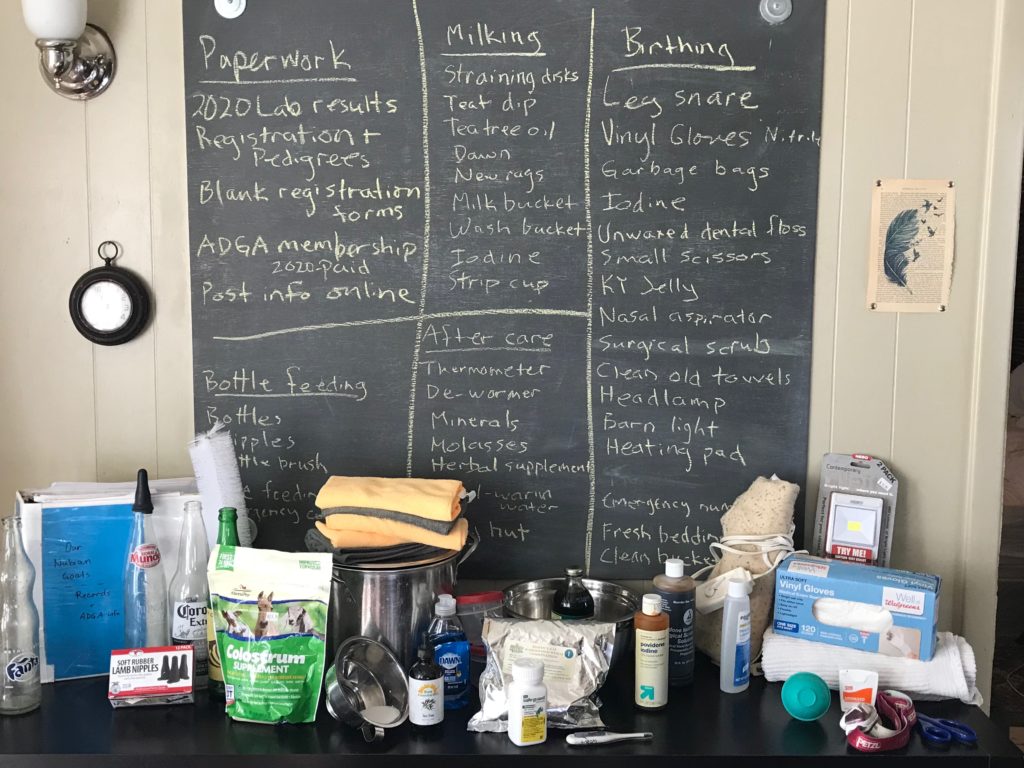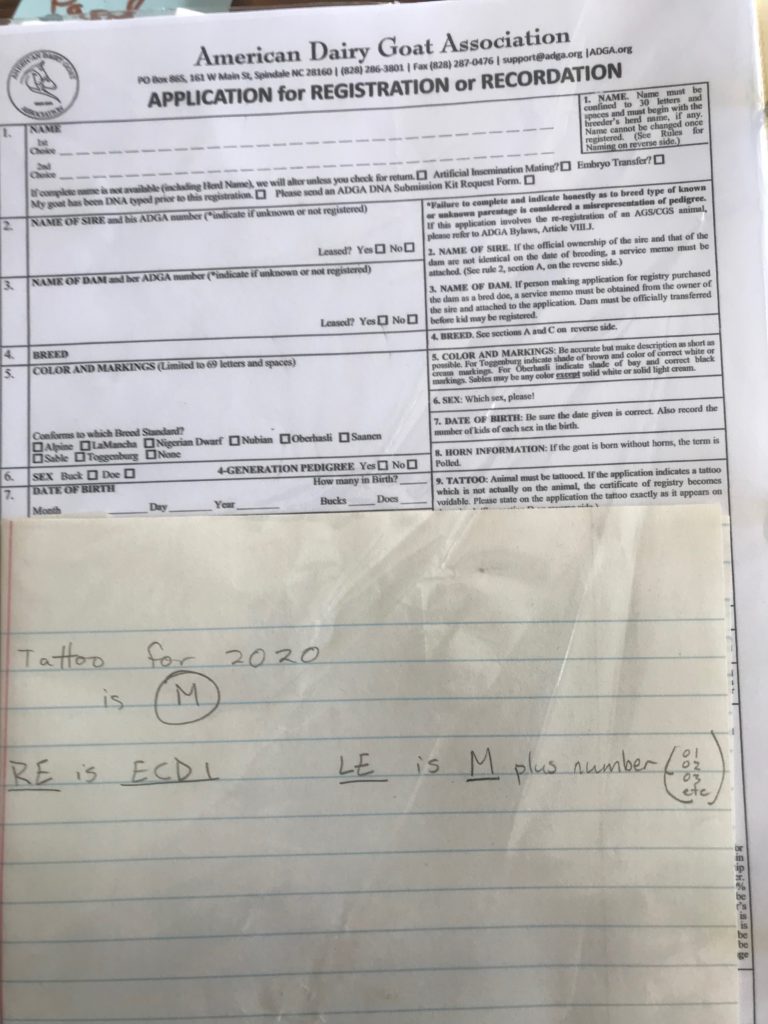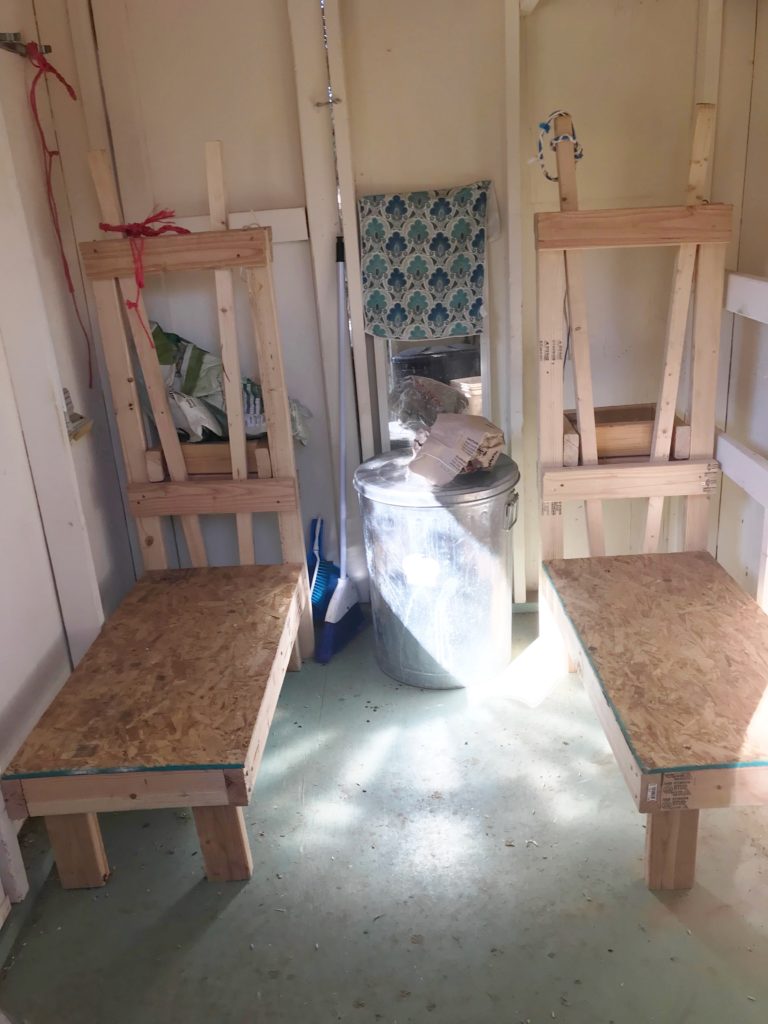
This is a long post. Because, lots of things need doing before welcoming new baby goats. And it illustrates Reason Number One why I can’t ever have my fantasy tiny house.
I’ve been writing lists and assembling supplies. Rose is looking close to ready, and those babies are coming soon. I’m not in a panic yet; her ligaments are still firm, but she’s showing signs that the time is near. Her udder looks a little more developed every day.
If you’re a visual learner it might be helpful to see, in photos, how I’m getting ready for kidding season. But heads up: I’m learning that there are two types of planners: Those that plan and purchase for every contingency, and those who are more laid back. I’m in the second category. My neighbor and goat partner (She owns Nigerian goats.) is in the first. There are good lists for every type of planner, but you should be aware that this is the fairly laid back list. Another caveat: I live in a warm climate. I’m not worried about babies freezing. They still need to be kept warm, especially for the first three days or so, but this is definitely a plan for warm weather.
So.
I’ve got plans for five parts of goat birthing. Not all will necessarily apply to your situation. They are: Paperwork, Birthing, After Care, Milking, and Bottle Feeding. I’ll lay it out in that order, and you can skip the parts that don’t apply to you.
First—Because I have ADGA registered goats and plan to sell the babies as ADGA registration applications, I have to get my paperwork in order first.
This includes:
Lab results that show that my goats have been recently tested for certain diseases (CAE, CL, Johne’s). I need extra copies in case purchasers want them. And I’ve learned not to count on my printer working at the last minute.
Disbudder/Tattooer’s contact information. Needs to be done 7-10 days after birth.
Pedigree, and registration papers for dams and sire.
Blank registration forms for each kid that’s born. I fill these out for the buyer, unless we do the forms online together during the purchase. I also fill one out to keep for myself, even if the buyer chooses not to register. It keeps a record of every kid born here. I’ve many times been glad the information was on hand.
This year’s tattoo information. So I’m not looking it up last minute.

If you’re intending to sell kids, you need to plan how you’re going to market them. Craigslist? A website? Goat forums? There are pros and cons to each one, but you do need a plan. Unfortunately, you can’t sell animals through Facebook. This is hard; Facebook groups allow us to get to know members, to create online and real-life communities, making it easier to “police” each other. A bad animal owner will be called out and people won’t sell to him or her. But now that Facebook has banned animal sales we’re all scrambling to find new places to sell. With Craigslist, I have no idea who the buyer is until he’s at my door to pick up a goat. I’ve had good success and made good goat friends through Craigslist, but I’m always nervous. I’m not selling if I don’t feel ok about the buyer.
Next up, the actual birthing list. This is the long one, and you can’t skip it.

The very first thing on the list is a leg snare, for pulling on the leg of a stuck baby goat. Full disclosure: I don’t have one, so you won’t find it in the above photo. I have small hands and I like to feel what I’m pulling on, so I don’t know when I’d ever use one. But if I had really large hands I’d get a leg snare. Don’t ask Amazon for one. When I searched “Leg Snare” the search engine was confused and suggested that maybe I was looking for “Lego Star”. I tried other combinations with “snare” and got “snare drum”. Another website called it a “kid pulling snare”. At that point I started wondering if Google would notify Child Protective Services if I searched for that. So if you want a leg snare, you’ll have to go find it yourself.
Vinyl or nitrile gloves. (I’m allergic to latex.) For touching icky things, and keeping germs off vulnerable things, and going in after stuck kids.
Garbage bags. Also for icky things.
Iodine, for dipping umbilical cord ends
Unwaxed dental floss, and small scissors, for tying and cutting umbilical cord, if necessary
KY Jelly, or similar lubricant, for going in after stuck kids, or smoothing the way for them. In my 50s, I’m still not mature enough to buy this without blushing.
Surgical scrub wash, usually made with iodine. Mine’s called Povidone Iodine Prep Solution, and Amazon can actually help you with this one. Wash with it before going in after a stuck kid.
Nasal aspirator. We called it a snot-sucker when our children were babies. And that’s what it’s for: Clearing snot and birth goo out of kids’ noses so they can breathe.
Clean old towels, two for each expected kid. I’m expecting Desert Rose to have two, but I’m preparing for three, ’cause this ain’t my first rodeo. If she has four, I’m not prepared. OMG
Head lamp. Would you believe I’ve never needed one for the actual birth? All my goats have kidded in the mid afternoon, every single time. But the first couple of days I’ll be milking for more colostrum in the middle of the night, so I do need it eventually.
Battery powered barn lamp. Optional, but if you don’t have electricity in your barn (I don’t.) this is the best thing ever. You can literally stick it to the wall, or hang it on a nail, IF your goats can’t reach it, and then you’ll have bright light in the barn. If they can reach it, you have bright light buried under the hay on the floor.
Here’s a link: https://www.amazon.com/Super-Bright-Switch-Wireless-Basement/dp/B01N03PQ65/ref=sr_1_7?keywords=flip+it+bright+light+where+you+need+it.&qid=1583541600&sr=8-7
I don’t make any money if you buy from Amazon, so if you prefer buying them elsewhere, go for it.
Heating pad. Can’t skip this one. Goats’ body temperatures are higher than ours (102-103 degrees), so, while cuddling them does help, if a goat is really cold your body temperature isn’t high enough to get its little body up to a number where it’ll be able to eat. A cuddle under your shirt WITH a heating pad is perfect.
Feeding tube and a 60cc syringe. This is the other one that I don’t have, and I should. However, before tube feeding a weak baby, try warming it up with the cuddle and heating pad. This has worked for me, and I’ve never tube fed a baby. They’ve always gotten hungry when they’ve warmed up. When I tried searching for a tube feeder and syringe on Amazon to provide a link, they suggested stuff to put oil in my car…
Clean buckets and new clean rags; access to hot water within minutes. For washing up you and mama goat.
Fresh bedding for before and probably after the birth. A clean space to birth, and then a clean space to rest after the goop of birthing. Pine shavings, clean straw, or clean hay that your goats already picked through are all ok.
Emergency phone numbers. Vet, second vet in case first vet isn’t available. Husband. I have a goat partner that lives down the street that also has goats, and also a couple of really great neighbor girls that are a big help. I need all their phone numbers on hand. Don’t invite everybody. Your goat needs peace and safety to do her best labor and delivery.
And that’s my complete “Delivery” list.
Next up: After Care

If you’re only going to pay attention to one category of the five I’m presenting here, please let it be this one. The care your goat gets after delivery can be life and death for your goat.
Unsulphured blackstrap molasses, and a bowl of lukewarm water. Add molasses to the water for a strengthening drink for your doe right after delivery. She’ll appreciate it and likely drink all of it really quickly.
Thermometer. To take goats’ rectal temperatures over the next few days. Goats’ normal body temperatures are 102-103 degrees. You’re going to want to check your doe, especially, twice a day for 3-4 days. If it gets higher than that after delivery, you’re probably calling the vet, ASAP.
De-wormer. This is a hard one. Right after a goat delivers, she’s really vulnerable to worms. You’ve got to do something to help her. I’ve used Safeguard for years. I’ve felt conflicted about it, but scared to go the natural route. Last time I used Molly’s Herbals and my goat had no problem at all. It felt like the right thing to do, but scary. I’m going to try it again this time, but I’ve got Safeguard on hand, just in case. You can buy Molly’s Herbals here:
https://fiascofarm.com/herbs/mollysherbals.php/categories/herbal-wormer
Goat minerals. Your goat should always have access to minerals, but especially now. If you’re not feeding alfalfa hay, you also might need extra supplements at this time. Calcium and selenium are recommended a lot. I just have a salt block with minerals formulated for goats. You can get loose minerals, too. Make sure they’re for goats, and have plenty of copper in them.
Kid hut. The kids need a cozy little hut to snuggle in. A 3 x 3 x 2 foot box, open on one side, is fine. Because my kids are bottle fed, this box is in my kitchen for the first few days. It’s made of cardboard. If they’re out with other goats it will need to be made of sturdier stuff.
Supplies for milking your goats will be needed at the same time as your after-care supplies, but will continue (hopefully) for many months. Even if you aren’t raising dairy goats, you need some plan for what you’ll do if your babies die, or your goat has some other reason she needs to be milked. I raise dairy goats, so milking them becomes a regular part of my life and my relationship with my goats. If you don’t have dairy goats, you can maybe be more loosey-goosey with this list.

A milk stand. I have two. I’m a fast milker; the goats take much longer to eat their grain than it takes me to milk them so having two of them on the stand at the same time is more efficient for me. And goats are always happier with a buddy. It’s a win-win. But you only really need one stand. Train them to get on it, eat their grain, and be handled before they deliver. Your life will be easier for it.
A bucket for water. For washing goats’ udders before milking. You’ll want to add things such as: a single drop of Dawn dish soap, three drops of tea tree oil, a couple of drops of iodine. Use a clean rag to thoroughly wash her udder, and another one to dry it, before milking. Add a couple of drops of lavender if you like, as well.
A small cup for each goat you’re milking. Use this as a “strip cup” to examine the first squeeze of milk from each teat. If there’s blood or any other strange thing, you’ll want to give yourself a heads up to check for mastitis. Don’t worry too much if a new goat has a bit of blood: Her udder is stretching, and a bit of blood for a day or two is probably normal. That first strip also clears germs from the opening of the teat, so it’s a safety measure for you, the milk drinker. Throw that first strip of milk away.
Another small cup for dipping teats after milking, to protect against mastitis. Add water and three drops of tea tree oil.
A stainless steel milk pail. You need something to milk into. Make sure it’s easy to clean and doesn’t have any seams that could hide germs.
Milk straining equipment. My first several years I just folded these discs into cones and poured the milk into them. https://www.amazon.com/KenAG-disc-non-gauze-filter-discs/dp/B01J2I8CO6/ref=pd_sbs_86_3/144-4602253-1459510?_encoding=UTF8&pd_rd_i=B01J2I8CO6&pd_rd_r=0acb9a1a-c22a-4070-8173-41ba7935cffa&pd_rd_w=DPs77&pd_rd_wg=aaJ4p&pf_rd_p=7cd8f929-4345-4bf2-a554-7d7588b3dd5f&pf_rd_r=76WN6EWAJM6FJ3NZK7GF&psc=1&refRID=76WN6EWAJM6FJ3NZK7GF
I now use this system instead. https://www.amazon.com/Stainless-Steel-Strainer-Dairy-Filters/dp/B00WRFB1H2/ref=pd_biab_3/144-4602253-1459510?_encoding=UTF8&pd_rd_i=B00WRFB1H2&pd_rd_r=66719704-10db-4d37-9925-019c8bfefe51&pd_rd_w=3q3VU&pd_rd_wg=VoGYo&pf_rd_p=a9c3b175-129c-434c-9c01-ddd7c78354eb&pf_rd_r=P2TJAZ0ER7NFVMRHBJ70&psc=1&refRID=P2TJAZ0ER7NFVMRHBJ70
And you’ll need clean glass jars with lids for storing milk.
Finally, you’ll need bottle feeding supplies.

Even if you’re not planning on bottle feeding baby goats, plan on it. If a mother can’t or won’t take a baby, you’ll have to feed it, and you need to be prepared.
Gather glass soda, beer, or sparkling water bottles, enough for each anticipated baby, plus one. You’ll need to top these with rubber lamb nipples. If your goat doesn’t seem to be getting milk quickly enough, you can slightly cut the hole a little bigger at the tip. I’ve used this system since I was a little girl and like it still.
Dried, powdered colostrum. It’s expensive. Hopefully you’ll never need it. But new baby goats MUST get colostrum, and quickly. In the terrible event that mama doesn’t have it for her babies, you’ve got to have it on hand. It’ll keep for years; hopefully it’s a one-time purchase that you never have to open.
A bottle brush that fits into the baby bottles. To wash bottles, of course.
If you’re not keeping mamas and babies together, you’ll need a pen and shelter for your babies to live in–and much sooner than you anticipate. Set this up now before they destroy, for instance, your beautifully planted side yard.
A feeding schedule. Post this somewhere so you don’t forget when and how much to feed the babies. Feeding schedules are discussed pretty hotly in groups I’ve been in: It seems like everyone’s got one and thinks everybody else’s is wrong. This is the one I use. All I can say is I’ve raised happy, healthy goats, and have never lost one. Yet…

Finally, you’re really gonna want to have a camera. Of course.
As much as this seems like the “laid back” list, it’s a lot, isn’t it? You should see my dining table right now! Between our March planting season and kidding season, it’s a mess of goat stuff and spring seeds and planting charts.
Questions? Let me know if you need more help locating some of these items. If you’re considering having goats, does this seem daunting or exciting?
And, experienced goat owners: did I miss anything?

Hi! My theme is twenty sixteen. I had to look it up; my brother helped me set up my website since I’m an urban farmer and not great at techie stuff at all. I’m glad you enjoy the site!
Thank you. All the best to you, too.